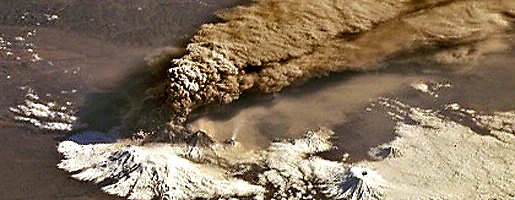 |
|||
|
The
1994 eruption of Klyuchevskaya, on the Kamchatka Peninsula.
|
|||
| VOLCANOES ON EARTH | |||
| Volcanic features are found at tectonic plate boundaries and in "hot spots" within continents or ocean basins. Volcanoes have built up where molten rock, or magma, from the Earth's interior erupts to the surface. 80% of Earth's erupted magma is the basaltic lava found elsewhere in the Solar System. Basalt is also the major component of the crust in the ocean basins. Basaltic lava has low silica content and is comparatively fluid, flowing a long way before solidifying and thus producing broad-based shield volcanoes and even thick horizontal sheets called lava plateaux. | |||
 Mauna Loa, Hawaii. Steam clouds are from a minor eruption and from lava flowing into the sea. |
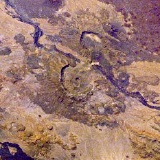 Dubbi Volcano, near the Red Sea, is the source of recent, dark lava flows. |
||
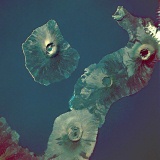 The Galapagos Islands are formed from the overlapping lava flows of several shield volcanoes. |
 Pic Tousside, in North Africa is at the centre of a 10x25 kilometres lava field. |
||
| Andesite and rhyolite are lavas with increasing proportions of silica, making them stiffer (more viscous) than basalt. They don't flow so far, producing volcanoes with steeper slopes. When dissolved gases are present in magma, pressure changes cause the gas to escape as the magma reaches the surface. In stiffer lava, the expanding gas can be trapped until it escapes explosively. This can produce airborne material, or tephra, with sizes varying from volcanic "bombs" , several centimetres across, to fine ash. Ash from large explosive eruptions can rise tens of kilometres into the atmosphere and spread thousands of kilometres horizontally and is easily seen from space. | |||
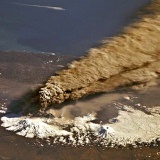 The 1994 eruption of Klyuchevskaya, on the Kamchatka Peninsula. |
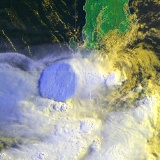 Mount Pinatubo erupted in 1991, punching ash (shown as blue) through the clouds and 20 kilometres into the stratosphere. |
||
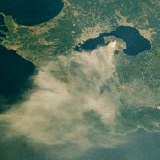 Sakura-Jima, Japan, erupts almost daily. |
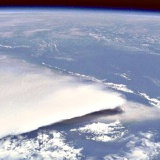 Ash from the eruption of Rabaul volcano is dispersed,causing water condensation over a wide area. |
||
| Tephra cones build up around the vents of explosive rhyolitic and andesitic volcanoes as the debris showers down, producing steep slopes of loose material. The highest volcanoes are stratovolcanoes, which emit both viscous lava (usually andesite) and tephra. The lava layers act to protect the tephra layers from erosion, allowing the volcano to build much higher than a simple tephra cone. | |||
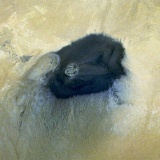 The black ash cone of Uau en Namus in the Sahara Desert. |
 The peaks of the Virunga Mountains of Africa. Smaller tephra cones are in the centre and lower right. |
||
 Mount Rainier, a snow-topped stratovolcano in North America. |
|
||
| Volcanoes can be recognised from Earth orbit by their circular form, often with a sizeable eruption crater at the summit. Extinct or dormant volcanoes can be heavily eroded, with a radial drainage pattern. Larger volcanoes may show a sizeable collapse crater, or caldera, where an empty magma chamber has collapsed, such as Ngorongoro in Tanzania. | |||
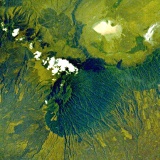 Ngorongoro Crater, East Africa, is a caldera, left after a huge eruption 3 million years ago. |
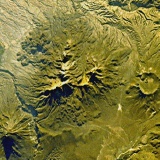 Circular form and radial drainage patterns in the Andes Mountains. |
||
 Kamchatka Peninsula. Secondary cones have grown from the floor of an old caldera (top), in contrast to the younger volcano (bottom). |
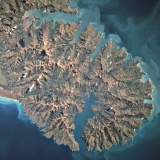 Banks Peninsula, New Zealand, recognisable as a volcanic feature due to its circular form and radial drainage. |
||
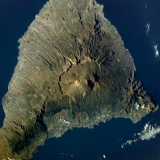 Tenerife, an extinct volcano rises 3,000m above sea level. |
|||
| There is some correlation between the composition of a lava and its position on a tectonic plate. Andesitic stratovolcanoes occur at continental margins where oceanic crust is subducted under continental crust. Rhyolitic magma is erupted mainly from the continental crust. Basaltic lava is extruded all along the mid-ocean ridges and basaltic shield volcanoes are found in the ocean basins. Basaltic lava is also erupted through the continental crust, however, indicating an origin in the mantle, beneath both types of crust. | |||
| Igneous rocks do not always make it to the surface before solidifying. Subsequent erosion, however, may expose them to view. Large igneous intrusions into the crust may uplift the overlying rock strata. Batholiths are large intrusions, up to 15 kilometres thick. Sills and dykes are thinner intrusions along weaknesses in the surrounding rock. Sills are sheets, up to 300 metres thick, running between the rock's bedding planes, while dykes run through fractures across the bedding planes. Laccoliths are mushroom-shaped intrusions between bedding planes which have caused the overlying strata to dome upwards. | |||
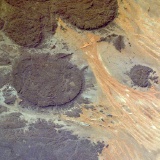 Volcanic ring complexes in the Air Massif of North Africa. |
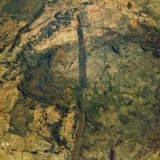 The Great Dyke, an igneous intrusion running across Zimbabwe. |
||
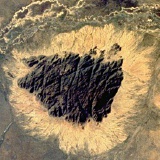 Dair Mountain, North Africa, a body of resistant igneous rock rising to 1000 metres. |
|||
|
|
|||
